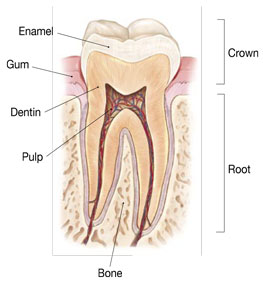Endodontics spotlight

Saving cracked teeth begins with early diagnosis and patient awareness
It may begin as a tiny fissure on the chewing surface of the tooth. The patient may not even be aware of its presence as repeated stress causes the crack to advance downward, dangerously close to the pulp — nerve and blood vessels — and further into the root. Dental advice is often not sought until symptoms manifest. Intermittent pain when chewing, sensitivity to hot and cold temperatures, and unpredictable stints of discomfort are all telltale signs. In other situations, a small crack can become a large one in a very short amount of time. Sometimes all it takes is an instant, especially when biting down on something hard or even something soft.

Even when a crack extends into the pulp, the connective tissues at the center of the tooth, endodontists can treat it with root canal treatment and crown to prevent its spread. But when it creeps below the gum line, the tooth often cannot be saved, and extraction ensues.
In some respects, endodontists have a good problem with which to contend: One major contributor to the observed uptick in cracked teeth cases is the increasing lifespan of the American population, which according to numbers from the Centers for Disease Control and Prevention, has reached 78.8 years.
“Due to the efforts of the American Dental Association and the dental profession, people learned how to prevent tooth decay and gum disease so they started to keep their teeth longer,” says Dr. Robert Roda, 1993 TAMBCD endodontic graduate. “Cracked teeth seem to be a result of repetitive stress injury, and so the longer teeth are in use, the more likely they will become cracked. This is a modern epidemic and something we have never before as a profession had to deal with.”
Endodontists are taking a proactive stance to educate patients on the oral health issue, says Roda, who maintains a practice in Scottsdale, Ariz., and is president of the American Association of Endodontists.
At Texas A&M University Baylor College of Dentistry, dental students and endodontic residents alike receive intensive didactic and diagnostic training on early detection methods, says Dr. Gerald N. Glickman, chair of the Department of Endodontics and director of the Advanced Program in Endodontics.
“We want them to be thoroughly informed on early detection and treatment modalities,” says Glickman, “as earlier detection and protection of teeth from the less severe cracks will keep them from propagating further, thus preventing tooth loss.”
When cracks in the teeth are not detected early, endodontists have their work cut out for them.
“Endodontists are the specialists in dental diagnosis, but sometimes cracked teeth will thwart even our best efforts,” Roda says. “The response of the pulp to a crack is sometimes very difficult to localize, and great care has to be exercised to not treat the wrong tooth.
“Sometimes cracks are plainly visible on the crown of a tooth as seen under the dental operating microscope, but sometimes they are hidden under fillings or other restorations, and they even occur on root surfaces under the gum line.”
The use of cone-beam computed tomography — a variation of traditional CT systems that uses a cone-shaped X-ray beam to produce 3-D patient images — has aided endodontists in diagnosis, but even that tool just allows them to infer the presence of a crack. All too often a fracture cannot be found without invasive surgery or until conventional therapies to save the tooth have failed, at which point extraction is the only remaining treatment option.
Considering the most effective and least invasive ways to avert the consequences of a cracked tooth include early diagnosis and preventive care, there is some good news: Patients, too, can take the offensive against this oral health concern.
Some pointers:
- Avoid chewing on hard objects — think ice, pens, unpopped popcorn kernels, etc.
- Don’t clench your jaw or grind your teeth — Since the stresses of daily life can often cause people to do this involuntarily, most often during sleep, talk to your dentist about getting fitted for a retainer or nightguard.
- Protect yourself — Wear a mouthguard or mask when participating in contact sports.
- Minimize decay — Fillings help stop the spread of cavities, but they can weaken the structure of the tooth and make it vulnerable to fracture. Preventing dental decay with healthy diet and oral hygiene choices can help mitigate this risk.
Why does a cracked tooth hurt?

A tooth is made up of white enamel, a hard layer called dentin and inner soft tissues known as pulp, which contain blood vessels and nerves. When the tooth’s outer layers are cracked, chewing can cause those pieces to move, irritating the pulp housed within it.
With time, tooth pulp damage can become irreversible. Intermittent pain when chewing can give way to sensitivity to hot and cold, and eventually, the tooth may hurt without warning.